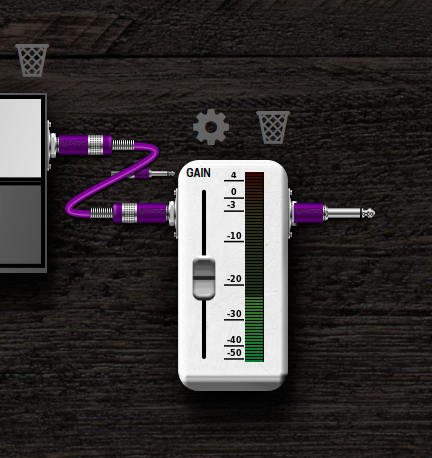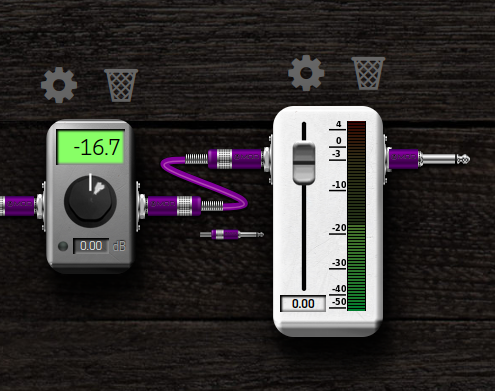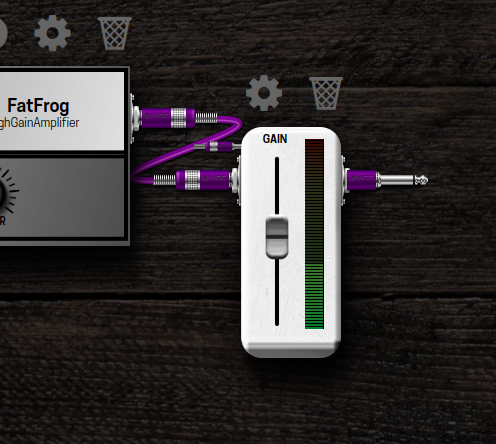I get you, but also feel that everyone already answered you to that. The leveling tool already exists in the platform (the gain plugins). If you can see clearly where the problem is happening and it’s caused on a plugin with no level control, you can always drop a tiny gain or a gain plugin in between and fix it. That’s why the meters will help you…only to find the issue quickly. Having any other direct way to control that not this would cause two things:
1st a more messy window/pedalboard;
2nd more work on developing the features what in other words means more time to actually get it developed.
This.
This applies to the Dwarf as well. Admittedly the latest version of the Dwarf’s firmware does allow you to change the input and output fairly quickly. But there are lots of other parameters that need to be manually assigned to knobs.
That’s great! If it could be made hideable and integrated into each cable it would be elegant.
I want to chime in again to say that in my opinion adding level controls to each plugin is not a nice solution for the problem of mysterious clipping audio. In general these things are addressed in phases: diagnosis & treatment. I would encourage diagnostic tools before the treatment tools. Especially because we already have the ability to manually treat the problem and it is significantly harder to diagnose the problem than to treat it.
I think the points about the portability of the pedal-board-creation process are orthogonal to the discussion around digital clipping. I don’t take a computer with me in my setup, I make sure I am not trying to edit pedalboards or debug gain-staging issues during a gig.
Lastly, It’s not like ableton or other platforms are adding gain knobs to every plugin you drop in. This is not a free operation: it costs platform resources to manage each of those. This now becomes more expensive the larger your board is. I don’t want the platform to take my precious signal processing resources without me having configured it to do that. It is not possible to make something like this ‘debug only’: if you choose to use one of those level controls and were to leave debug mode, now that level control is somehow in your live board and not ‘debug only’ after all.
Sorry for the long message format, I have a background in software design and wanted to point out some of the finer points to why I disagree with the solution. Physical hardware resources and technical complexity for engineering resources as well as end-user experience all have to be considered. Appreciate everyone’s points - just adding my two cents.
With scale it may be a bit more useful. And I agree with @thomasomans here. Implementing such a “plug” into any cable will be a overkill. It may be useful while creating a pedalboard, just to check the levels between different plugs, but at least, you must know, in the digital domain there is nearly no clipping possible. In the digital domain, any single sample value could go up/down to FLT_MAX/FLT_MIN which means 3.40282347e+38F/1.175494351e-38F (38F means 38 zeros before the point.) So clipping will only happen here when the algorithm in the plug do that. Still, it may be interesting to check the levels here and there. At least, when the signal leave the digital domain and run into the DAC, it needs to be bounded to +1/-1, as that is the point were the clipping happen.

I think that this is precisely the approach that has made the Dwarf so frustrating to use. It needs a lot more refinement than it has. I would be happy to use a gain plugin if they were more like the size of @brummer ‘s proposed idea. Currently even the simplest plugins like Gain are too big in my opinion. Also, using a gain plugin is a workaround not an elegant solution.
The Dwarf could be world class but there seems to be a bit of resistance to the idea of actually working to refine it and imbue some elegance to its design.
I don’t know what you mean here. The 3rd encoder is by default assigned to the stereo gain of the default pedalboard and you have the Quick Items that by default as well have the input and output gains there.
Without knowing a lot about the code behind the cables I think that would be possible. But in the end, this would end up in an extremely messy pedalboard even with a few effects. I feel that this is like if in a physical pedalboard you had a volume pedal in between each since pair of pedals.
I agree 100% with you. That’s why I feel that the meter is important, but the immediate leveling control it’s not so much.
Maybe you are missing something. I didn’t see exactly the dimensions of @brummer plugin (maybe he can share it with us), but in a quick view, it actually seems bigger than the “tiny gain plugin” that also has a sort of meter on it. Altough I agree that not as good and able to be precise as @brummer proposes.
In less than one week I mapped alone more than 30 proposes for improvements coming from the community (including many from this thread), many more are mapped from before.
@jesse (our Product Specialist) will now need to have time to go over them and organize/analyze them all. So, I guess that saying that we have “a bit of resistance to the idea of actually working to refine it and imbue some elegance to its design” is definitely an overstatement.

Yes, it is naturally bigger then the TinyGain and the TinyGain is as well precise in it’s display. It’s just a other kind of view.
Yes. But personally, I feel yours more precise because we can quickly see how close we are from hitting those yellow or red LEDs 
Hello João @jon
https://forum.moddevices.com/uploads/default/original/2X/4/499be8cb2c17ba13393c632b0456d11904d97c45.jpeg
I would suggest the Level Meter to have a cable to draw or drop from it itself instead to have a jack to draw cables to. If you would touch the cable it should unplug immediately where it was plugged into.
I have another suggestion regarding @brummer Hermann’s idea.
Greetings and God bless
Hello @brummer Hermann and @jon João,
as long as we are in the digital domain there is no clipping involved, only if the signal exceeds the number range at the DAC.
You suggest some sort of LED VU meter which I would like to see and use immediately.
The range of the slider should be configurable for those who would like to tweak coarse or fine…
My proposal is to show RMS and Peak level the same time. A simple “Over” LED on top should work instead the +4 we would see in an analogous VU meter… If a DAW has a +4dB VU Meter when would the needle exceed the 0dB point?
I would suggest 0dB(Clip), -6dB, -12dB, -18dB, -24dB or a better range of signal steps.
There are so many options available like the K-weighted scale.
I’d like to hear what others might think about it.
Greetings and God bless, Marius
I disagree. If you can hide the meter and level control imbedded in each cable, you effectively will see the same layout as normal unless you click on the little “i” just as you would on other plugins.
That’s not the behaviour I’m seeing in my Dwarf. I have to click on the first button to get to the input and output controls. Otherwise there is nothing assigned to any of the knobs.
Couldn’t we just add like little R/Y/G dots on the input/output of each plugin?
Green is good, red is clip, yellow is up to the artist based on overall mix?
I’d love to just see a simple dot that can be applied to the I/O of the plugin near the connection points. Just like how the physical hardware responds to I/O.
My argument for I/O monitoring is that you’d have the ability to see exactly where the hot signal is coming from in your chain based on plugin.
If a plugin up the chain showing a yellow dot on output would hint at a red dot on the output of the next, then I’d interpret that as needing a gain plugin installed between the the two to shore up the gain stage line.
That’s just my opinion, and my mod devices are studio set up, so maybe my solution is more oriented to my uses.
yeah a colored ring on the plug on the in/outs that are connected for example
I proposed an overlay or something like that as well to have the “dashboard view” but dots or rings (that you can turn on and off) would do the same.
This seems to be the best proposal I read so far.
Having a meter monitor on the cables is nice, but does not solve the problem.
You could have 3 perfectly leveled cables plugged in the same input that added together cause clipping.
Monitoring should be done on each plugin input and output to be reliable.
And I think the simple and trusted G/Y/R led works perfectly fine. When you get a red you lower the volume of whatever before it that’s overloading the plugin, either by lowering previous plugins’ inputs or by putting a tinygain if you can’t.
I want to like this idea, too! It has so many upsides: It could be “always on” and the pedals would not have to be changed (hence it can be implemented by the MOD team). I am just afraid, that it will not work with all pedals: some are simply made for clipping (distortion anybody?) and I believe many will produce artefacts way before the actual clipping rate. And we will not be able to clearly distiguish between the two.
Nevertheless, enhancing the cable ends seems feasible for the volume controls @Gino is so fiercely advocating for. Why not make the respective cable area responsive to mouse actions and let the user scroll up and down for volume changes? The metering part could then just be a popup.
That wouldn’t really work because of the way the signal flows. Any way I will be mapping your feedback.
